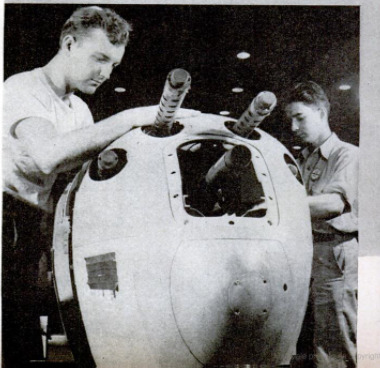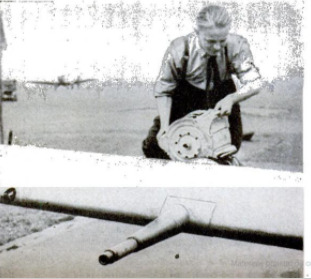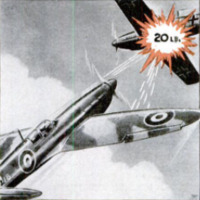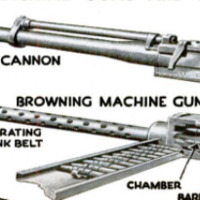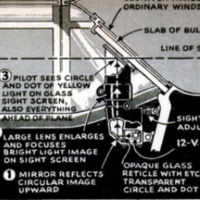-
Title (Dublin Core)
-
New guns for planes
-
Article Title and/or Image Caption (Dublin Core)
-
Flying gun carriers
-
extracted text (Extract Text)
-
TOMORROW'S decisive air battles
will be won by toughly armored fly-
ing gun carriers packing a weight of
fire power far greater than that of the
most gun-bristling fighter planes of
today.
Aircraft designers and builders of all
the major powers are engaged in a
breakneck industrial race, trying to
satisfy the armed forces’ insatiable de-
mands for stronger, better-protected planes,
and heavier, more destructive guns to
mount in them. Some types of planes al-
ready are firing projectiles powerful enough
to smash light tanks and motor transport.
Bigger guns are being tried out experiment-
ally, and some students of ordnance predict
the emergence of an air-cruiser type armed
with guns of three-inch caliber or larger,
possibly embodying rocket principles or
some other means of fire capable of over-
coming the serious problem of recoil.
In short, the science of aircraft arma-
ment, born in the First World War and
more or less stagnant in the 20 years that
followed, is now moving ahead again at full
speed under the insistent pressure of a big-
ger and tougher war.
Even in this air-minded day, few
Americans realize how greatly air-
plane fire power has been boosted.
The one-place fighter plane offers a
good basis of comparison. By 1918,
in the closing period of the war, both
sides had settled on a main fighter
type armed with two rifle-caliber
machine guns attached to the fuse-
lage and fitted with synchronizers
enabling them to fire through the
propeller arc without damaging the
blades.
With that armament a pilot who
managed to line up an enemy in his
sights for a reasonable burst-—say
five seconds—could pepper the foe
with about 166 bullets having a to-
tal weight of four pounds. Just be-
fore the outbreak of this war the
most heavily armed fighter plane in
service was the British Hurricane,
with eight .303 caliber machine guns
firing from the wings. The same
five-second burst from these ships
delivered around 800 bullets, weigh-
ing 20 pounds—or 400 percent more weight.
One of the most heavily gunned planes on
fighter duty in Europe today is the Royal
Air Force's Spitfire IX, which goes into ac-
tion with four .303 caliber machine guns
and two 20-mm. automatic cannon spitting
lead, steel, high explosive, and destruction.
In five seconds the ship can fire 400 ma-
chine-gun bullets and 120 20-mm. armor-
piercing or high-explosive shells. The total
weight of the blast runs around 45 pounds
more than eleven times that of the 1918
plane.
That kind of development in fire power is
the logical outcome of a corresponding de-
velopment in the armor protection of the
bombers which are the fighter's natural
enemy and prey. The rise of air warfare
has brought about a repetition in this field
of the long-standing race between ordnance
and armor plate in naval design. As usual,
gun power seems to have the edge, yet the
ability of some new bombers, especially the
American heavy types, to absorb punish-
ment and shoot back has proved a painful
shock to many an overconfident Axis fight-
er pilot.
The first military aircraft were not armed
at all. The top commanders in 1914 re-
garded their planes as observation devices,
somewhat more mobile than captive bal-
loons but no more aggressive. Individual
pilots took the initiative by carrying car-
bines, pistols, or shotguns aloft and potting
away at enemy ships that ventured within
range.
The next step was to mount a light ma-
chine gun on the ship, and the simplest ar-
rangement was to have the gun on a swivel
to be operated by the gunner in a two-place
plane. But single-seater ships had far
greater speed and maneuverability, so it
was clear that the ideal fighter would be
one in which the pilot could do his own
shooting, aiming the entire plane at the
target and firing the fixed gun by
remote control.
A gun bolted to the center of the
upper wing could fire above the pro-
peller arc, but it created wind re-
sistance and forced the pilot to stand
up if he had to clear a jam or change
ammunition pans. This arrangement.
was superseded by the development
of the first practical synchronizer
by Anthony Fokker, Dutch aircraft
‘manufacturer.
Fokker's device consisted of a
cam mechanism placed between the
airplane engine and the machine
gun's action. It was a tricky, cranky
gadget, but when lined up and ad-
justed with loving care it worked,
by restricting the gun's discharge
to the brief instants when the pro-
peller blades were in a horizontal
position and out of the line of fire.
The Germans had the inside track
on Fokker's invention and enjoyed a
brief advantage—until British and
French engineers duplicated the de-
vice.
Both sides continued to experi-
ment with new ideas in aircraft
weapons, but the synchronizer was
the only development that really
made itself felt in actual combat. All efforts
to mount heavier guns, for example, were
inconclusive. The British started work on
an automatic one-pounder cannon, but the
war was over before much progress had
been made with the design. In 1917 the
French Hispano-Suiza company brought
out a short-barreled 37-mm. gun mounted
in the notch of a V-type engine and firing
through a hollow propeller hub.
This gun was a single-shot type, and thus
completely lacking in true air fire power,
but its mount was exceedingly well thought
out, and variations of it are used today in
cannon-firing planes.
The Germans, meanwhile, had worked on
a Becker 20-mm. gun with a 12-shot
magazine. It never was very success-
ful, and after the war the owner sold
out his patents to the Swiss Oerlikon
firm. What happened later is an inter-
esting example of how military designs
circulate. Oerlikon continued to de-
velop the design, and later sold patent
rights to Hispano-Suiza. The French
firm, in turn, passed its designs on to
the British. Later the United States
took it over, modified and improved the
design, and is now using a so-called
Hispano 20-mm. in some versions of
the P-38 Lightning and P-39 Airacobra
fighter planes. The Germans also have
a short-barreled Oerlikon FF model,
but are known to be replacing it with
a high-velocity Mauser 20-mm. gun.
Our own ordnance experts carried on
numerous experiments during World
War I, one of them involving the Davis
“no-recoll” gun, an unconventional
weapon of about 2%-inch bore. It was
recognized that the element of recoil
was one of the biggest limitations to
the firing of powerful guns from air-
craft. The Davis gun tried to solve
this by discharging a dummy slug or
a load of shot backwards from its
elongated breech at the instant the ac-
tual projectile was fired from the muz-
zle, so that the counteracting forces
balanced each other and eliminated re-
coil at the gun's mount.
Army ordnance even considered using
a five-inch gun of this type, but after
thorough tests the Davis gun was dis-
carded, mainly because it could not be
aimed quickly and because the breech
discharge was found to be just about
as dangerous to near-by friendly air-
craft as its projectile was to the enemy.
Later a light 75-mm. mountain howitz-
er was prepared for plane mounting, but
was never test-fired.
America’s greatest progress, how-
ever, was made in the development of
specialized aircraft machine guns, and
the pioneer work was carried out by
our “gun wizard,” the late J. M. Brown-
ing, probably the world's greatest de-
signer of automatic weapons.
Browning, the designer of the entire
family of machine guns used by the
U. 8." armed forces, first concentrated
on a 30 caliber aircraft machine gun,
and produced a 22-pound, air-cooled
weapon with a rate of fire of 1,200
shots a minute. It snaps out 150-grain
bullets (about 47 to the pound) with a
muzzle velocity of 2,750 feet a second.
The same Browning design in a .303
caliber ver-
sion is now the standard British aircraft
machine gun.
But U.S. airmen now favor the larger
Browning 50 caliber air-cooled gun, and
say flatly that it is the finest large-caliber
aircraft machine gun in the world, Weigh-
ing less than three times as much as its
little brother, it throws four times as much
lead per second, and throws it with a heav-
fer punch. The muzzle velocity of its 800-
grain (nine to the pound) bullets is 2,900
feet a second, and after they have traveled
1,800 feet in less than three quarters of a
second they still have a striking velocity
of 1,950 feet compared with the .30 cali-
ber's 1,500 feet. The .50's rate of fire ranges
from 700 to 850 shots a minute, depending
on whether it is firing free or is slowed
down by synchronization with the propeller.
A synchronized Browning is fired by a
mechanical trigger motor attached to its
receiver and connected through a solenoid
and semiflexible tube with an impulse gen-
erator which is part of the airplane engine.
This is really a form of high-speed semi-
automatic fire, since the trigger motor ac-
tuates the trigger for each shot. This de-
vice, produced by Army Air Force engi-
neers, is a vast improvement over the often
unreliable hydraulic, rocker, and flexible-
shaft synchronizers used in 1918.
Nevertheless, modern practice tends in-
creasingly toward the use of wing guns to
avoid any synchronizer and to take advan-
tage of the gun's full rate of fire. The wing-
mounted gun is fired by a remote-controlled
solenoid, and continues to fire as long as the
trigger is depressed and the ammunition
holds out. Occasional trouble with belt-fed
ammunition has been eliminated by the
U.S. development of a disintegrating me-
tallic-link belt. Each cartridge, acting as a
pin, joins two metal links. When an empty
cartridge case is extracted and ejected, the
empty links that held it to the rest of the
belt fall apart and tumble out with it.
The development of more efficient armor
naturally stimulated the demand for harder-
hitting guns. The United States was well
abreast of the trend and by the time the
present war started had an excellent 37-
mm. cannon ready for production. This gun,
with a bore of about 11; inches, is recoil-
operated and fires 1%-pound high-explosive
shells at a rate of 125 to 150 a minute. The
shells have supersensitive nose fuses which
will burst the charge on contact with the
lightest airplane fabric. Armor-piercing
shells of about two pounds also are fired.
-
Contributor (Dublin Core)
-
Arthur Grahame (Article Writer)
-
Language (Dublin Core)
-
eng
-
Date Issued (Dublin Core)
-
1943-09
-
pages (Bibliographic Ontology)
-
82-87, 212
-
Rights (Dublin Core)
-
Public Domain (Google Books)
-
Archived by (Dublin Core)
-
Matteo Ridolfi
-
Marco Bortolami (editor)
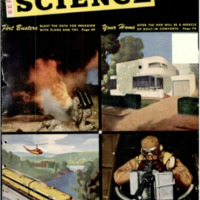 Popular Science Monthly, v. 143, n. 3, 1943
Popular Science Monthly, v. 143, n. 3, 1943

